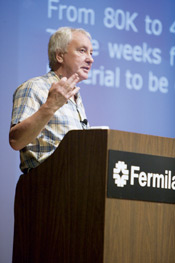Commentary: Lyn Evans
 |
| Photo: Reidar Hahn, Fermilab |
A truly international accelerator
Every time I take visitors to see the Large Hadron Collider, I’m reminded of the extent of the international collaboration that has made this project possible. Although the majority of the LHC was produced in Europe through collaboration between CERN and industry, a walk through the accelerator tunnel tells an international story.
The 27-kilometer-long LHC consists of eight arcs joined by straight sections. These straight sections, each about 200 meters long, highlight the contributions from nations that are not CERN member states. Entering the tunnel at access point 1 next to the ATLAS experiment, for example, the first thing you see are the Japanese and American flags on the final-focusing inner-triplet magnets. The magnets are powered through a feed box made at the Lawrence Berkeley National Laboratory in California and are sitting on precision jacks from India. Next come six magnets made in Novosibirsk, Russia. They bring the beam trajectories together for collision.
A little farther on, there’s a neutron absorber from Berkeley and a superconducting magnet from Brookhaven National Laboratory in New York that puts the beams on parallel trajectories. After that come the quench resistors and main arc feed boxes, also from Russia. In the next three kilometers of arc are more than 150 superconducting magnets built by European industry.
Less visible are the pulsed electronic systems and quadrupole magnets from Canada, the multipole corrector magnets made in India, and support structures from Pakistan.
Collaboration of this kind has long been the norm in particle detectors, but the LHC is the first major particle accelerator to be built with substantial contributions from beyond the host laboratory. What has made this possible is the long history of collaboration among particle physics laboratories around the world.
When CERN was founded in the 1950s, Brookhaven was probably the new European lab’s main competitor—and also its best friend. Both labs were building new machines. A development at Brookhaven opened the road to higher energies, an advance that Brookhaven immediately shared with CERN. As a result, CERN could build the proton synchrotron as a 28 GeV machine instead of a 10 GeV machine and briefly hold the world energy record before Brookhaven switched on the Alternating Gradient Synchrotron.
In my younger days, I spent many hours in the control room of Fermilab’s Tevatron, always during those beautiful Chicago months of January and February when the CERN machines were shut down for maintenance. The experience I gained there on the world’s first superconducting synchrotron served me well in later years.
For our part, CERN has never hesitated to share the results of our own accelerator innovation. Inviting partner labs to join in the construction of the LHC was a natural next step in this long tradition of cooperation.
We at CERN are all looking forward to switching on the LHC in 2008, an event that will be closely tracked in the United States via Fermilab’s Remote Operations Center. That event will launch the next level of our global collaboration: a new era of discovery at the high-energy frontier.
Lyn Evans is the LHC project leader at CERN.
Click here to download the pdf version of this article.


